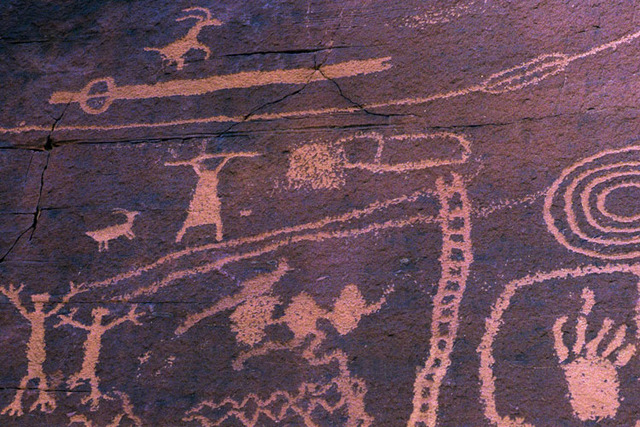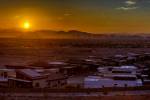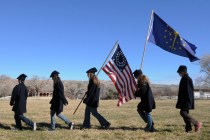Ancient cultures left mark on Southwest

The Southwest is blessed with cultural remnants of native people who inhabited the region long before the arrival of the Spanish and the subsequent flood of European settlers. Because most early cultures left no written record, we have gleaned much of what we know of them from the ruins, relics and artifacts they left behind.
The early inhabitants of the Mojave Desert left fewer signs since they were nomadic hunters and foragers, living mostly in small groups that followed the seasons. Where there was enough water, they planted beans, corn and squash in small patches.
Their imprint upon the land was light, marked by a few heavy implements left for use at favorite campsites, stone points and the chips left when making them, broken pottery, traces of foot trails and rock art in spots that were important to them. Since the rock art took time and effort to produce, it must have had significance to them. Some of the symbols and depictions probably had spiritual meaning.
The ancient artists left three kinds of rock art. Petroglyphs, designs pecked into rock surfaces, are the most common. Pictographs, painted symbols and handprints on stone faces, are less durable and found only in protected places. The rarest of all rock art are the glyphs found incised into the ground itself. Called intaglios or geoglyphs, this rock art form involved scraping away the wind-swept desert surface stones to reveal the lighter earth below. Known geoglyphs take the form of evenly spaced tracks like trails in a maze or enormous figures and symbols so large they are best viewed from the air.
There are about 600 known geoglyphs, most in Southern California and Arizona. More than 200 of them lie along the Colorado River from Nevada to the Gulf of California. For their protection, their exact locations on public, private and reservation lands are often kept secret, including a recent discovery of an ancient maze on a federal military base near Barstow, Calif.
The first geoglyphs discovered from the air in 1932 by a pilot flying from Las Vegas to Blythe, Calif., are the best known and most accessible. The Blythe Intaglios are about 180 miles from Las Vegas west of U.S. Highway 95 about 15 miles north of Blythe. They include three neighboring sites, each with a large human figure and two with a four-legged creature. A snaky-looking spiral writhes near one of the animals.
To reach the area, follow U.S. 95 south from Las Vegas to Interstate 40 near Needles, Calif. Head east on I-40 to the exit for the Needles Airport, which will put you back on U.S. 95 skirting the river. Continue south 78 miles toward Blythe. Watch for a side road on the right marked by a Bureau of Land Management sign. Turn off the highway onto a short graded road to park near two adjacent groups of geoglyphs surrounded by fences. The third fenced group is a short hike away, reached by a little trail. Experts believe these intaglios date back anywhere from a few hundred years to 2,000 years.
The fences are protection against further damage to the sites, which became the target of irresponsible off-roaders years ago. The tire tracks remain as clear today as when they first marred these vulnerable cultural treasures, which are listed on the National Register of Historic Places.
The glyphs remained undiscovered in the desert for so long because they are very large and difficult to see from the ground. One of the human figures measures 171 feet. Perhaps the ancient artists meant for these figures to be seen only from the air. Bring a ladder, stand in your truck bed or climb up your RV’s roof ladder for a better view. Some motivated visitors make arrangements to fly over the site from Blythe in small airplanes.
Other ancient geoglyphs in the vicinity include the Topock Maze just off I-40, a huge snake near Yuma, Ariz., a figure with a spear above two fish dubbed “The Fisherman” north of Quartzite, Ariz., and two 18-foot human figures thought to represent the hero twins of native mythology near Fort Mohave Reservation, Ariz.
Margo Bartlett Pesek’s column appears on Sundays.


















